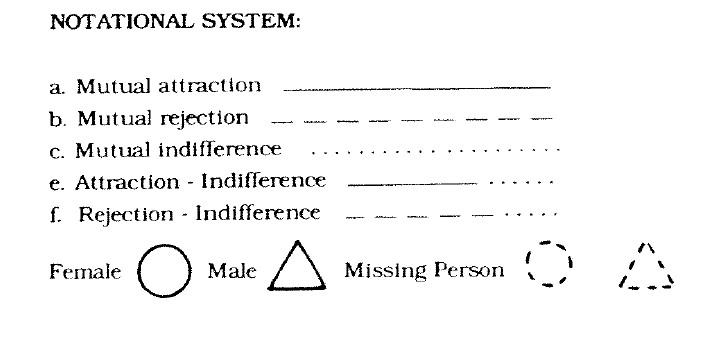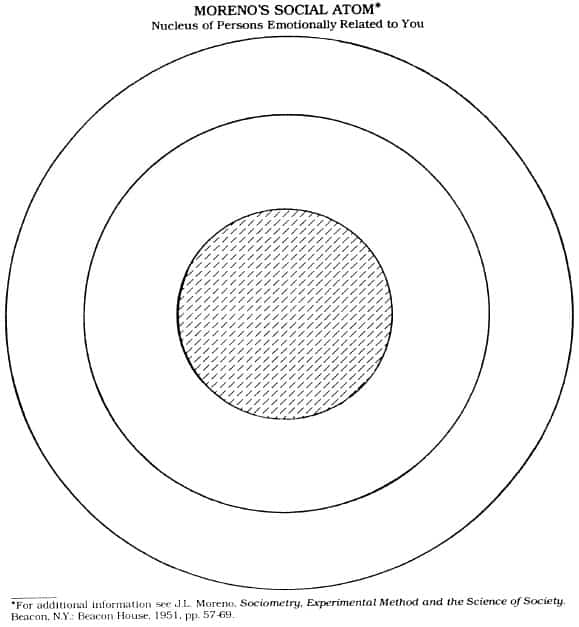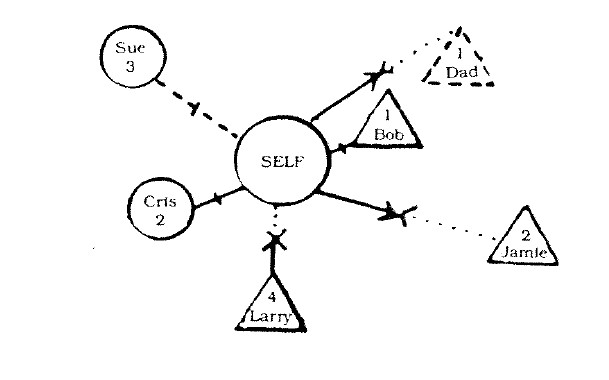The social atom is one of Moreno’s important and novel developments. It was born out of his study of the science of interpersonal relationships (sociometry).
J.L. Moreno was a pioneer in the field of group psychotherapy. His concept of the social atom has become a key tool for understanding the dynamics of relationships and groups. Moreno developed the concept of the social atom as a way to understand the complex interactions between individuals and groups.
What is a Social Atom?
Moreno’s social atom is the composite of the significant people within our lives at any given time point. It is a diagrammatic representation of a person’s social network. It includes family members, friends, colleagues, and other acquaintances.
The social atom exercise involves the use of paper and pencil to capture the relationships in our lives at any point in time; past, present or future.

The social atom uses triangles for males, circles for females and squares for institutions.
A social atom is like a genogram. It is also different because it is fluid. Therefore, a social atom can assess and reflect a person’s social network, including institutions.
One way to construct a social atom consists of concentric circles, which represent the different levels of closeness in a person’s social network.
One way to construct a social atom consists of concentric circles, which represent the different levels of closeness in a person’s social network.
The innermost circle represents the individual. The next circle represents their intimate relationships, such as family members, romantic partners, and close friends.The third circle represents the person’s social network, including acquaintances and colleagues.

However, people tend not to fit so neatly into the concentric circles. Those with whom we have an challenged intimate relationship may at present be in an outermost rather than the innermost circle. This is because the emotional closeness of this relationship, which is the primary unit of measurement, is less than it could potentially or ought to be.
Use of the Social Atom in Individual and Group Therapy
Therapists can use the social atom in patient care in a variety of ways. The social atom can be used as a diagnostic tool. A completed social atom can help therapists better understand their patients’ social networks and the relationships that are most important to them. This can provide important insights into the patient’s behavior, emotions, and mental health. Consequently, the therapist can use the social atom to identify areas for intervention.
The therapist can also use the social atom can be used as a therapeutic tool. It can help patients to explore and understand their relationships with others. By visualizing their social network, patients can gain a greater understanding of the dynamics at play.
The therapist can use the social atom also to help patients identify patterns of behavior that may be contributing to their problems. This can help patients to develop new strategies for managing their relationships. The social atom processing can lead to improved mental health and well-being.
The social atom can be used to facilitate group therapy, by helping participants to visualize the relationships within the group. By identifying the different roles and relationships within the group, participants can gain a better understanding of the dynamics at play, and can develop new strategies for working together. This can lead to improved communication, increased empathy, and greater group cohesion.
Application in Psychodrama – Moreno as a Social Atom Repairman
When J.L. Moreno referred to himself as a “social atom repairman,” he was emphasizing his belief that social problems arise from disruptions or malfunctions in the relationships between individuals and groups. He believed that social problems could be effectively addressed by repairing these relationships and restoring balance to the social atom. As a social atom repairman, Moreno saw his role as helping individuals and groups to repair their relationships.
Moreno viewed individuals as the fundamental units of society and believed that social problems could be traced back to issues within individual relationships. He believed that individuals and groups were interconnected and that any dysfunction in one relationship could impact other relationships and the wider social fabric.
He developed a range of techniques and interventions to help individuals and groups to better understand themselves and their relationships. They can also be used to develop new strategies for managing their relationships.
One of the key applications of the social atom is in psychodrama. Through role reversal, psychodrama aims to help individuals to better understand themselves and their relationships.

The social atom is a useful tool in psychodrama. This is because it allows individuals to visualize their relationships and explore the dynamics that are at play.
Moreno’s psychodrama technique was one way that he helped individuals to repair their relationships. By allowing individuals to act out their feelings and experiences in a safe and supportive environment, Moreno believed that they could gain a better understanding of their own behavior and the behavior of others. This could lead to improved communication, increased empathy, and greater mutual understanding. Together this all helps to repair damaged relationships and restore balance to the social atom.
How Criminal Defense Lawyer Can Use the Social Atom
Criminal defense lawyers can use the social atom to help prepare a sentence mitigation story on a criminal case by creating a visual representation of the defendant’s social network and relationships. This can help the lawyer to present a more nuanced and holistic view of the defendant’s character and background, and to highlight any factors that may have contributed to the defendant’s involvement in the criminal offense.
To create a social atom for a criminal case, the lawyer would start by asking the defendant to identify the key people in their social network, such as family members, friends, colleagues, and other acquaintances. The lawyer would then categorize these individuals based on the level of intimacy and closeness they have with the defendant, and create a visual representation of the social atom, with the defendant at the center and their closest relationships in the innermost circle.
Once the social atom has been created, the lawyer can use it to identify any factors that may have contributed to the defendant’s involvement in the criminal offense. For example, the social atom may reveal that the defendant was struggling with addiction, or that they were under a great deal of financial stress. By understanding these factors, the lawyer can develop a more nuanced and sympathetic view of the defendant’s situation, and present this information to the court as part of their sentence mitigation story.
In addition to identifying mitigating factors, the social atom can also help the lawyer to identify potential sources of support and assistance for the defendant. For example, the social atom may reveal that the defendant has strong ties to their family or community, and that these individuals may be willing to provide support and guidance to the defendant as they work to address the underlying issues that contributed to their involvement in the criminal offense.
By using the social atom to prepare a sentence mitigation story, lawyers can present a more complete and compelling view of the defendant’s character and background. This can help to humanize the defendant and to provide a more nuanced understanding of the circumstances that led to their involvement in the criminal offense. Ultimately, this can help to mitigate the sentence imposed by the court and to provide the defendant with a better chance of rehabilitation and successful reentry into society.

